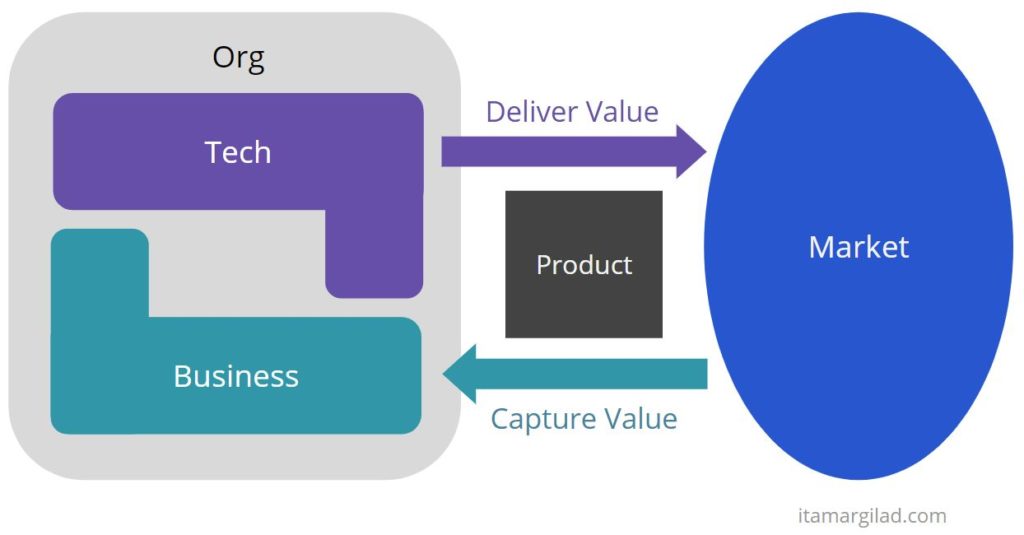(Update: this article used to be called “Product-led is Just as Bad as Sales-Driven”. This conflicted with the term “product-led growth” [PLG] which threw people off. I replaced all the uses of product-led to make it clear I’m not talking about PLG).
A common complaint I hear from product folk is that management is too “sales-driven”. It is a common ailment indeed, but I can tell you that the opposite condition, the strictly “product-focused” company, is pretty bad too. Both companies suffer from over-focus and a narrow worldview. A sales-focused company sees business success as the top priority and the product as a means to an end. The product-focused company views building great products as the prime objective and believes revenue is a happy by-product. Almost every organization I meet has its bias towards one philosophy or the other. It’s as if there’s a knob somewhere that controls what we deem most important.

The position of this knob has profound effect on your company: its mission, what it considers success, how it thinks about customers and users, how it approaches product development, and who calls the shots. Being a product person in a heavily sales-focused company sucks. Many fantasize about life in a heavily product-centric company. I’m here to tell you that’s not great either. To understand why let’s look at the two extreme ends of the spectrum.
The Sales-Focused Company
The mission of the sales-focused company (as clearly stated in its mission statement) is to become a “market leader” — to own the market, yield high profit margins, and rack in the money. The market is the territory over which the company and its competitors battle, and is assumed to be predictable, well-understood, and of finite size. The mindset is one of war—win market share, form alliances, displace the competition, be the last man standing.

The customers (never users) are cherished, but thought of as assets to capture and defend. Having a differentiated product is cool, but a me-too product is just as good if you’re business-smart. The product should have every conceivable feature— never leaving any customer wanting. The business teams and top execs are the only ones allowed to talk to customers and naturally they dictate to the “delivery” teams what to build (you don’t ask the workers in the assembly line what car to build). Unfortunately these engineering/designer folk tend to miss every deadline and to create products that are full of bugs and missing functionality—undoubtedly a performance issue or matter of “wrong culture”. Hence the company is always on a lookout for magic solutions (“Agile”, “Product Owners”, “OKRs”). Maybe one of those will fix “velocity” and help these incompetent delivery people get it together.
The Product-Focused Company
The mission of product-focused companies is to change the world with breakthrough products and 10x technologies. They’re led by visionaries who believe that some products are simply magical—they spontaneously blow people’s minds and disrupt entire markets just because they are so good. A magical product has to be highly innovative (10x/Moonshot/All-in), well-designed, well-engineered, elegant, and delightful. The users are important, but they’re there mostly to fall in love with the product, use it repeatedly, and create word of mouth (oh, and to pay).

The beating heart of the company is its product teams, full of rockstar developers, designers and PMs, and rich in methodology and “culture”. But these folks are compelled to follow the grand vision of management, which leads to convoluted product extravaganzas that don’t blow anyone away. But that’s because we targeted the wrong users, or we’re ahead of our time, or they simply don’t get it. Anyway, by the time the product finally ships the managers are already in love with a new shiny object. The business plan is “if you build it they will come”, but if that doesn’t work, Marketing and Sales will take care of it (luckily any idiot can market and sell a magical product). However these business simpletons are not allowed to interfere with the product and are rarely consulted.
Sign up to my free newsletter to get articles like this delivered to your inbox
Strange, But True
The two companies I described are of course exaggerated caricatures (no one can be this gullible, right?). And yet I’m sure certain things sound familiar. Even if your company isn’t this extreme, there’s always a bias. Small companies are usually heavily affected by the background of their founders—engineers or MBAs. In larger companies the executive team is more diverse, but different CxOs incentivize their departments to focus on different things—building great products or growing the business (leaving the other as “not our problem”). The assumption is that the differing points of view will balance each other and we will end up with some golden halfway point that has the best of both worlds. In reality all we get is misalignment, friction, running around in circles, and companies that don’t excel at either product or sales.
The Market-Focused Company
The sales-focused company and the product-focused company have something in common—they’re both self-centered. One is only interested in winning market-share and enriching itself. The other is trying to feed its ego by wowing the world with its ingenuity.
There’s a better option—to be Market-focused. Here’s how market-focused companies see the world.

The mission of the company is to deliver lots of value to its market and to capture value back. Delivering value means addressing customers’ needs very well at a reasonable cost. Capturing value means obtaining revenue, market share, data, attention, and other resources we need to fuel the company. The two reinforce each other. Delivering high value is the best thing you can do to grow the business. Capturing lots of value means we have more resources to invest in improving our products and services and delivering yet more value. It’s a virtuous loop.
For the market-focused company, product and business are two sides of the same coin. Whether you’re an engineer, a designer, a product manager, a marketer, a sales-rep, a customer support specialist, or anything else, your goal is the same—to accelerate the flywheel of value-delivery and value-capture. Everyone is expected to contribute to both aspects of the goal.
(By the way, I prefer market-focused to customer-focused because we’re not living in a vacuum with our customers. There are partners, resellers, developers, and other third parties. There are also market trends, competitive and alternative products, and other contexts in which our customers live. Being market-focused means closely observing all of these and creating solutions that are mindful of the entire market.)
So in reality the real balance isn’t between Sales and Product. It’s between focusing on our own needs and on the needs of our market.

I suggest we should move this knob a long way (although not all the way) to the right. Strong focus on the needs of the market is the bedrock of truly great products and flourishing businesses.
Lean Product Management Workshops
In my Lean Product Management workshops you’ll learn how to develop product strategy, research your market, set goals, prioritize ideas, experiment, and work effectively with managers, agile teams, and stakeholders. I include unique frameworks and tools such as GIST, the Confidence Meter, and the AFTER framework, which you won’t find anywhere else.
These consistently highly-rated workshops are designed for product managers/owners, product directors/VP/CPO, and for product leadership teams (PM, UX, eng-lead, data, researchers).
Both public workshops and company-specific workshops are available now.
How To Become a Market-Focused Company
I’ll use the four parts of the GIST Framework to illustrate what’s different about product-focused marketing (not because they all use GIST, but because I find it useful to break things this way):
Goals
- The mission is about benefiting the customers (classic example: “Organizing the world’s information and making it universally accessible and useful”). Every company wants to become a market-leader. Putting this into the mission statement adds no information.
- The goals are measured by how much value we deliver and how much we capture.
- The goals don’t dictate solutions. We want to leave ourselves open to different options, based on what we learn from the market.
Ideas
- The company is humble and understands that its own views of what the users and customers want may be limited or plain wrong.
- Ideas are picked based on their potential impact on the market and the company irrespective of who came up with them.
- We’re willing to give many ideas a go and pick based on the market’s response (AKA market evidence).
- Decisions are made based on evidence rather than opinions.
Steps
- Projects are built step-wise in short mini-projects that develop the idea somewhat and test it.
- The idea is constantly reevaluated based on what we learn in each step.
- Decisions whether to persevere with the idea, change it, or park it, are made based on new evidence.
Tasks
- Product teams are cross functional (at a minimum having a product manager to represent the market and the business, and sometimes also relevant business stakeholders).
- Product teams are given goals that measure success by changes in user/customer behavior.
- The product team understands the needs of the users and the business.
- The team is involved in setting goals, evaluating ideas, planning experiments and interpreting results.
- The team has direct access to customers and users.
This is a partial list. There’s also continuous research, identifying and predicting trends, creating market-aware strategies and more.
I’m sure none of this comes as a surprise to you. Still very few companies manage to be truly market-focused. It’s a hard change because of the beliefs and biases ingrained into us in our education, training and work experiences. No company is perfect, and there will always be preferences. The key point is to realize where we’re being too self-centric, and to gradually shift the focus to the market.
Sign up to my monthly free newsletter to get articles like this delivered to your inbox


“The mission of product-focused companies is to change the world with breakthrough products and 10x technologies. They’re led by visionaries who believe that some products are simply magical—they spontaneously blow people’s minds and disrupt entire markets just because they are so good.”
Are you thinking of research-based companies? I’ve never actually seen what you describe outside of Hollywood parodies, or internet straw man arguments. I know you’re being hyperbolic, but this isn’t even in the same direction as any internet startups I’ve worked at.
All the product-based companies I’ve seen are quite grounded. If anything, their flaw is that they’re *too* grounded. It’s almost impossible to sell a product that does X when there already exist 20 X’s on the market, even if you think you’re improving on all of them. It’s a struggle to get even 1/20th of the market, no matter how good your product is. Those incumbents aren’t sitting at 5% because they hate growth.
The traditional example is restaurants. Every restauranteur thinks they can put good food on the table, and it turns out they’re right, and yet most restaurants fail within a year anyway. A solid product is not sufficient. I assure you none of the dozen restaurants in my neighborhood who go out of business every year thought they were selling “breakthrough 10x” bowls of rice.
Great post. The free newsletter link in this article doesn’t work.
Almost no company is this extreme, and it is indeed a less common phenomenon, but it does exist. As product people we’re more likely to notice sales-bias, than tech-bias, which might explain why it feels like it this is a non-issue.
Hi Itamar
This is a very refreshing read. I’ve worked both in sales-led and tech-led companies, and I agree that there’s an inherent blindness from either one with regards to the other. There is also a deafness to what the customer wants…..or thinks they want.
It’s really great when you do hear what problem the customer is trying to solve and you have enough clever tech to create a good solution.
Thanks, Jean-Marc. Fixed.